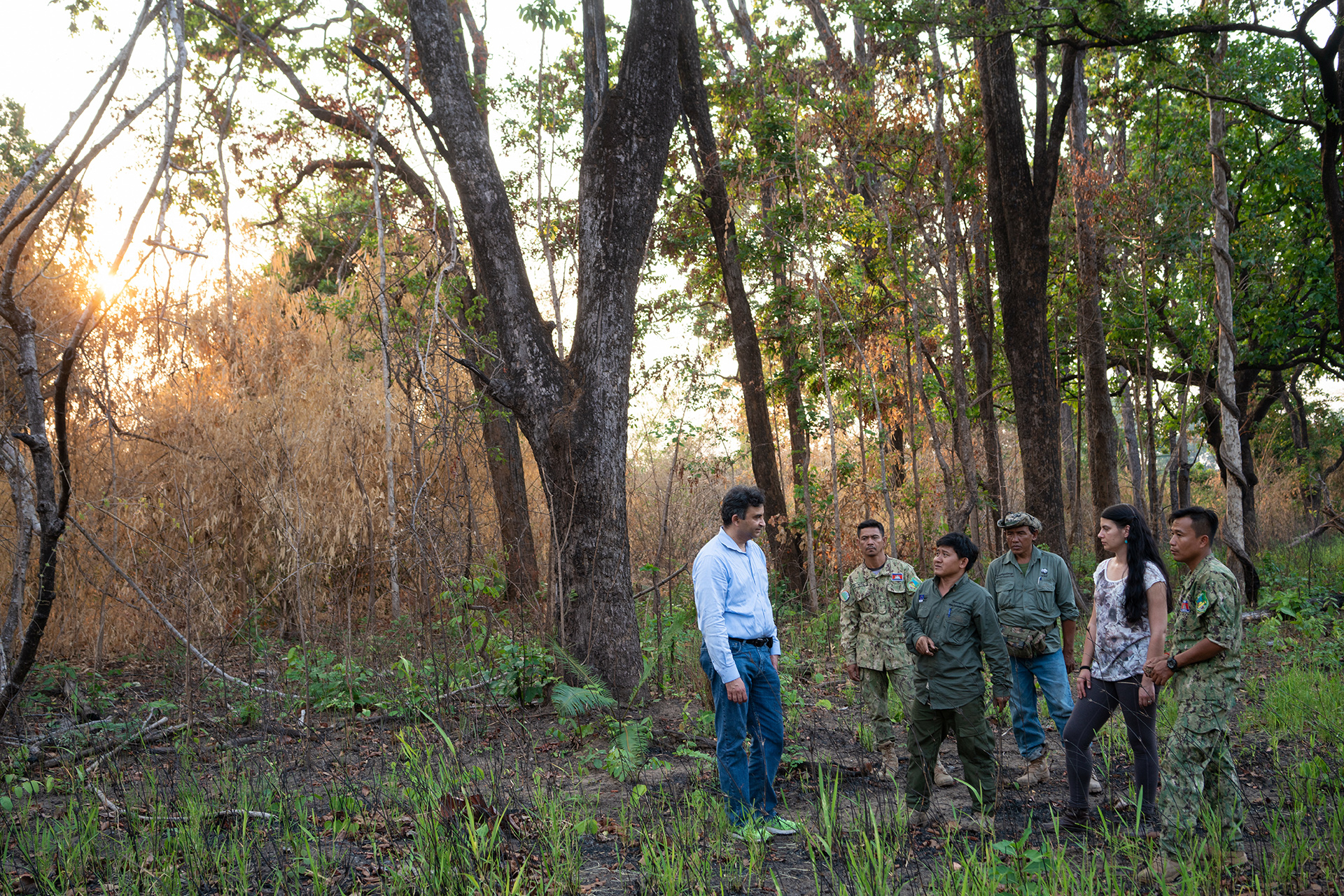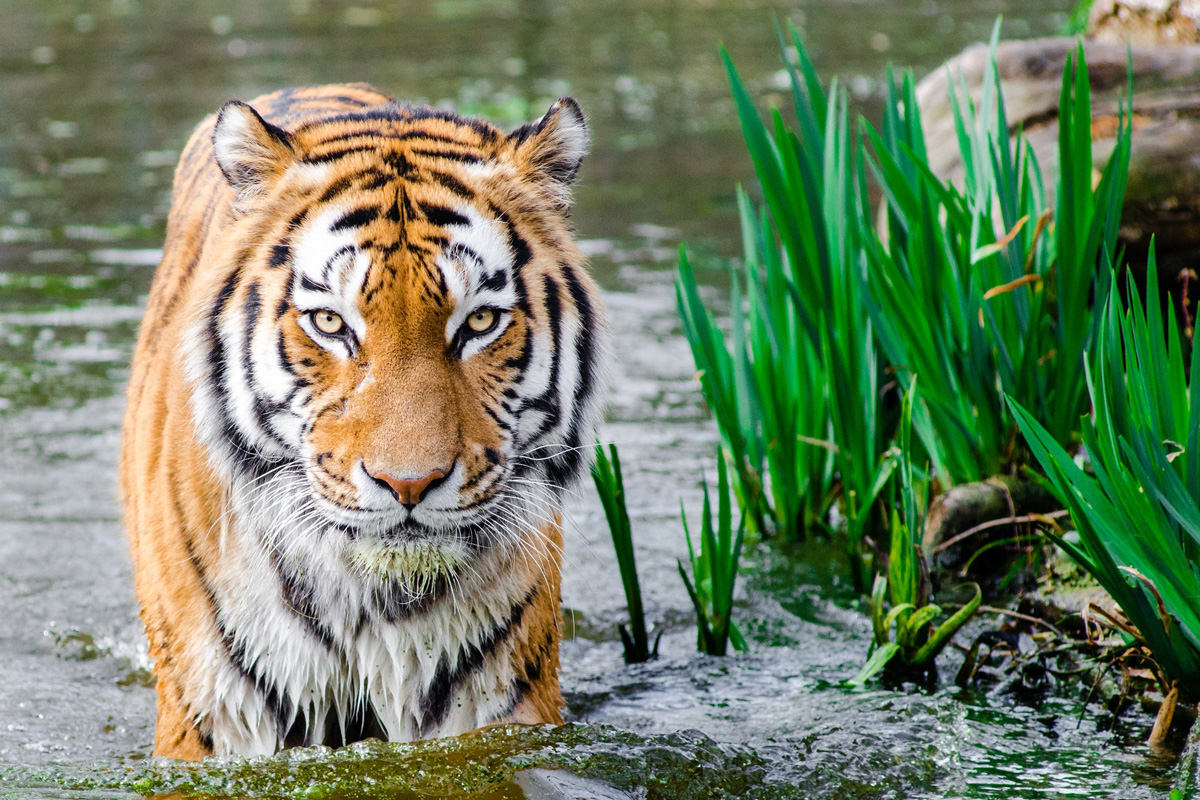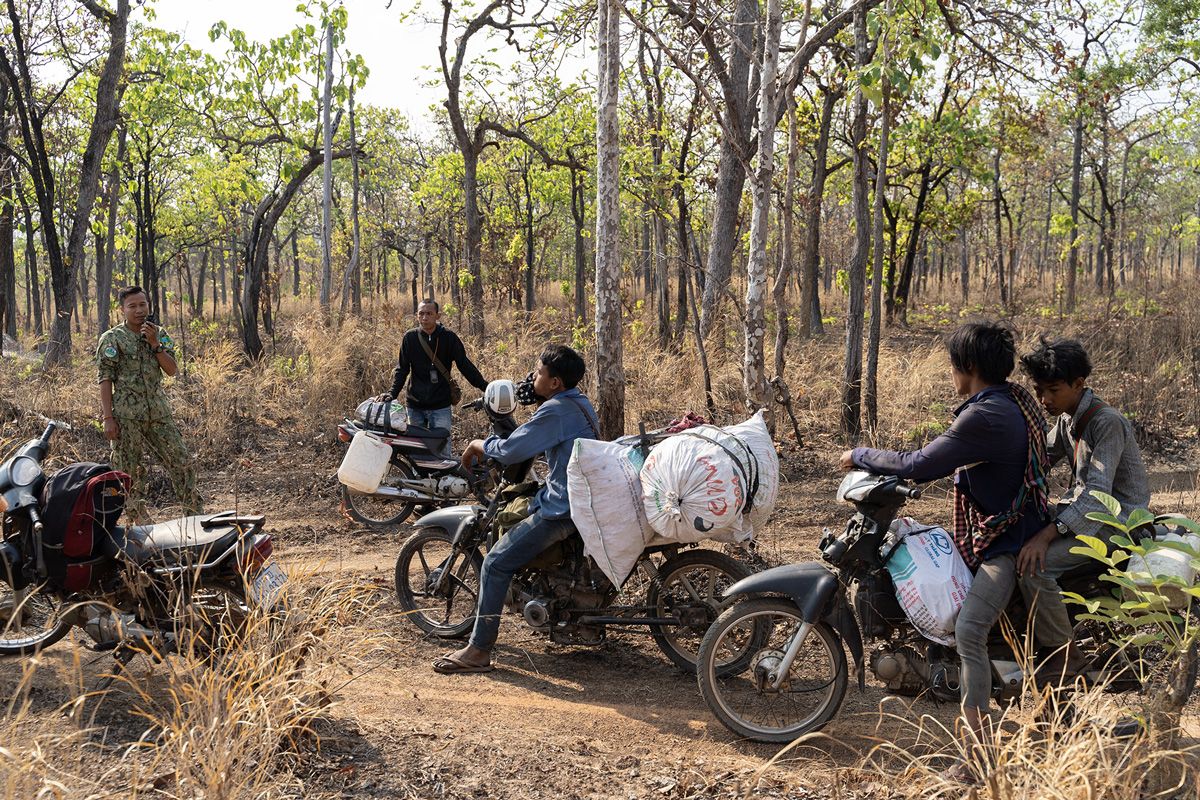Sothear Chheng has one of the toughest jobs anywhere.
Two generations ago, this was a remote corner of the Ho Chi Minh Trail in eastern Cambodia. Now, on this steamy February morning, Chheng leads his team into Srepok Wildlife Sanctuary for another long, exhausting and potentially dangerous day.
Clad in camouflage green, Chheng leads seven rangers who fall into formation behind him. They walk single file. Their stoic faces betray a mixture of determination and slight fear, their eyes constantly scanning for animal snares, footprints, bullet cartridges and motorbike tracks — telltale signs of poachers. Suddenly, the sound of a chainsaw in the distance shatters the silence.
Chheng’s face tightens. Illegal loggers could mean poachers. And poachers could mean …
Last year, poachers murdered four Cambodian rangers, and they have killed 10 over the past five years, according to Rohit Singh, a former ranger and president of Ranger Federation Asia, which oversees ranger training throughout Asia. In early February, illegal hunters shot and injured a Srepok ranger in a firefight. After his evacuation, poachers pumped his abandoned motorbike with 13 bullets.
Chheng raises him arm for the rangers to stop, then opens his arms wide, a sign for them to spread out and deploy behind trees and desiccated stalks of grass. The rangers slowly advance.
Undermanned and outgunned, rangers in Cambodia face the nearly impossible task of protecting animals under constant assault by ruthless, motivated and wily bad guys. “Rangers risk their lives every day,” said Singh, who leads WWF (World Wildlife Fund) Zero Poaching. He has the word “ranger” tattooed across his forearm.
Making matters worse, Chheng and his 71 colleagues at Srepok patrol an area measuring 3,700 square kilometers — more than three times the size of Los Angeles and five times bigger than Singapore.
Just 20 years ago, Cambodia had a robust tiger population. Today, the country has no tigers. Poaching has left Cambodia’s once-robust leopard population near extinction. The indiscriminate use of snares has emptied entire parks of animals, with 113 species in Southeast Asia in imminent danger because of bushmeat hunting and trapping, according to a 2016 study published in the journal Royal Society Open Science. Wild dogs and other animals with no market value are left to rot.
For rangers, deciding when and where to patrol to thwart poaching has been largely an educated guessing game — until now.

A New Weapon Against Poachers
Chheng has a new weapon in the battle against poachers: Protection Assistant for Wildlife Security (PAWS), predictive AI software that crunches massive amounts of data and leverages machine learning to suggest the most effective patrol routes. More accurate than human intuition, the software employs mathematical modeling and game theory.
The brainchild of Professor Milind Tambe, a USC Viterbi computer scientist and co-founder of the USC Center for Artificial Intelligence in Society (CAIS), PAWS uses algorithms to intelligently randomize ranger schedules to combat poaching by keeping the poachers off-balance, making it impossible for them to identify exploitable patrol patterns. Poachers have no idea when and where rangers will appear.
Through its integration with the Spatial Monitoring and Reporting Tool (SMART), PAWS could be introduced into about 100 wildlife sanctuaries in Africa and Asia by early next year, and 300 to 600 worldwide by the end of 2020, according to Jonathan Palmer, chief technology officer of the SMART partnership, a consortium of nine global conservation agencies including Wildlife Conservation Society (WCS), WWF and Panthera, and more than 60 governmental partners committed to improving the management of protected areas around the world.
SMART is a digital tracking tool that allows rangers to collect and manage patrol data, said Palmer, who also serves as executive director of strategic technology at WCS. Conservation agencies have successfully deployed it at natural reserves around the world, leveraging historical data to help rangers identify areas likely to attract illicit hunting and logging. Unlike PAWS, though, SMART cannot predict poaching hotspots. That’s why the combination of SMART and PAWS should prove so powerful.
“PAWS will deliver insights into protected areas around the world using artificial intelligence that weren’t even possible to dream about five years ago,” Palmer said. “Those insights will help rangers better protect wildlife everywhere.”
Bistra Dilkina, a USC Viterbi assistant professor in computer science and CAIS associate director, added, “We could be in 600 protected areas around the world in more than 55 countries. That would really put PAWS at the forefront of the movement to fight poaching on a global scale.”
Tambe, the Helen N. and Emmett H. Jones Professor in Engineering, has conducted AI research for more than 30 years. He and his team of researchers have employed AI technology similar to PAWS to improve security at Los Angeles International Airport, to better protect American ports and to optimally deploy Federal Air Marshals to prevent airplane terror.
“There are a few names in the computer science world that immediately pop up at the intersection of AI and conservation, and Milind Tambe is one of them,” said Lucas Joppa, chief environmental officer at Microsoft, which has supported Tambe’s AI work, and co-author with him on an academic journal article about PAWS. “Milind and his students are truly pioneers in the practice of deploying key artificial intelligence theories into environmental conservation practice.”
PAWS in Cambodia
Since late last year, Cambodian rangers have tested PAWS at Srepok wildlife sanctuaries with promising results. Twenty-four rangers patrolling areas identified by PAWS recovered more than 1,000 snares from mid-December to late January, more than double before the deployment of the AI software, according to James Lourens, law enforcement technical adviser for the Srepok Wildlife Sanctuary. Rangers also found 42 chainsaws, 24 motorbikes and one truck.
“PAWS helped us move from a reactive position to a more proactive approach,” he said. “I’ve been really happy with the results.”
Initially, Lourens said, rangers expressed skepticism about PAWS. However, as they saw its potential, morale increased to the point that they wanted to spend more time in the field to stop poa
Field testing is expected to continue until the summer, with rangers patrolling new and larger territories identified by the software, said Lily Xu, a first-year USC Viterbi Ph.D. student who works on PAWS with Tambe. To maximize outcomes, PAWS will leverage machine learning to “incorporate data from the December and January field tests, which will give us a richer and more accurate models,” she said.
A Most Formidable Adversary
In Srepok, an estimated 20 percent of poachers come from Vietnam and other Asian countries, sometimes with ties to the mafia, said Singh. They are well-armed and well-organized. During nightly patrols, rangers often hear poachers shooting park animals.
The majority of the country’s illegal hunters are Cambodian and mostly snare wild game, such as wild deer and wild pigs. The reason: booming markets in Southeast Asia for such fare.
“They hunt for food and business,” said Ly Bora, deputy director of the Srepok Wildlife Sanctuary.
Through an extensive education campaign, Srepok rangers have successfully persuaded many locals to eschew illegal hunting, Singh said. After becoming aware of the ecological dangers posed by poaching, some of them have even formed volunteer patrol teams to help protect their resources, he added.
However, anti-poaching admonitions occasionally go unheeded. Nhor Lean thinks he understands why. Decades ago, Lean and a group of illegal hunters snared five tigers; he personally shot another one himself. They ate the meat and sold the skin, teeth and bones for big profits.
“When I saw the blood coming out of the tiger, I was happy because of all the money we would be getting,” Lean said.
In 2000, he became a Srepok ranger, recruited because of his knowledge of the forest and success as a poacher. Lean now tracks elephants for research purposes to protect them. His best efforts notwithstanding, a handful of members in neighboring areas continue to poach. “They tell me that when I can get them a good job like I have, then they’ll consider quitting,” Lean said.
High Stakes
Humanity is living through the sixth mass extinction in the past 500 years. Natural disasters triggered the first five, each of which wiped out 80 to 90 percent of all species. Unlike those, however, mankind bears responsibility for our current predicament, according to Elizabeth Kolbert, the Pulitzer Prize-winning author of “The Sixth Extinction: An Unnatural History.” Major causes include human-induced climate change, habitat loss and unsustainable hunting, especially poaching.
The world’s tiger population now stands at about 4,000. Although that represents a small increase over recent years, it’s still dramatically lower than the 100,000 in the wild in 1900, according to WWF. The number of rhinos has plunged to 30,000 today from about 500,000 at the beginning of the 20th century. Similarly, there were a few million African elephants and about 100,000 Asian elephants at the turn of the 20th century. Today, there are an estimated 450,000 to 700,000 African elephants and 35,000 to 40,000 Asian elephants, according to Defenders of Wildlife.
The loss of habitat, sometimes through illegal logging, accounts for much of that decline. Illegal hunting, however, also plays a major role in the loss of so many tigers, rhinos and elephants. Organized gangs slaughter tigers for their skins and parts, which are used for traditional medicine, folk remedies and, increasingly, as status symbols in some Asian cultures; rhinos for their horns, also used in traditional Chinese medicine; and elephants for their skin and ivory tusks, which are carved into jewelry.
Indiscriminate snaring and driftnets have decimated wildlife globally. Since 1970, mammal, bird, fish and reptile populations have plunged 60 percent, according to WWF’s 2018 Living Planet Report. Plants have also disappeared. The risk to the planet’s fragile ecosystem couldn’t be higher.
“I tend to refer to [biodiversity loss] as a silent killer,” Cristina Pasca Palmer, executive secretary of the UN Convention on Biological Diversity recently told BBC News. “The impact is not as visible as climate change, but in many respects, it’s a lot more dangerous.”
Environmentalists believe the world must immediately make several important changes to stop the current mass extinction. Suggestions include better protecting land and oceans, promoting cleaner energy to slow climate change, reducing population growth to preserve natural resources, reducing meat consumption, and redoubling efforts to fight poaching and illegal wildlife trafficking, which nets criminals tens of billions of dollars annually.
PAWS alone certainly won’t reverse the sixth extinction or stop poaching — it is no silver bullet. However, the innovative software has the potential make a meaningful contribution in combating illegal hunting.
“It is really saving animal lives in the forest,” Lourens said. “I think it should be used in other parks around the world.”

AI in Action
PAWS uses machine learning to predict poachers’ behavior based on when and where rangers have found snares; terrain steepness; the location of rivers, streams and other waterways where animals conregate; and park roads that illegal hunters might use to enter and exit wildlife preserves, said Shahrzad Gholami, a USC Viterbi Ph.D. computer science student working on the project.
PAWS then produces maps that divide nature reserves into patrolling grids. Areas with the highest likelihood of poaching are color-coded red.
Srepok was divided into 15 regions, with five designated at high risk, five at medium risk and five at low risk of illegal hunting. Rangers found nearly five times more illegal activity in the high-risk areas than in the low-risk ones, affirming the predictive accuracy of the PAWS model, said Xu.
PAWS also provides additional protection to high-value assets through what Tambe calls “intelligent randomization.” That means important areas receive extra protection, while less important ones receive less oversight. In the future, Gholami said, PAWS could become even more effective by incorporating weather data, better animal density information, and perhaps even drone images identifying poachers and their routes. The more data, the better.
“We want to identify areas with a high likelihood of poaching activities — hot spots,” Gholami said, “to help the park rangers to direct their resources to those places to maximize their findings of poaching activities, such as snares and traps.”
To avoid sending rangers to the same areas, PAWS directs them to new parts of the park, including lower-risk areas they might never have visited. Doing so protects animals by confusing would-be poachers, Tambe said.
“What PAWS can do is say, ‘Given that I am protecting some high-risk areas, are there other areas that are now going to have a higher risk because they are not protected?’” he explained. “So it’s going to ensure the randomized patrolling of these other areas to make sure their risk is also reduced.”
The research is rooted in mathematical game theory — often used by economists and psychologists — that tries to predict outcomes of how conflict might play out between adversaries. According to the Bayesian Stackelberg game theory, the offense (the poachers) observes the defense (park rangers) to identify and take advantage of security weaknesses. The software, through the creation of intelligently randomized schedules, keeps poachers guessing.
A Success Story
PAWS’ early success in Cambodia should come as little surprise.
In the largest controlled field experiments of AI-prediction ever conducted, rangers in Uganda’s Queen Elizabeth National Park tested PAWS between November 2016 and June 2017. The software directed rangers to infrequently patrolled regions that PAWS identified as magnets for poachers, said Gholami. The rangers, despite their initial skepticism, “went to those areas and found lots of snares and traps there. Our predictive model showed them hotspots they would have otherwise missed,” she said.
To underscore its predictive capabilities, a second field test took place in Uganda’s Murchsion Falls between November 2017 and March 2018. This time, PAWS crunched data to identify areas of high and low risk for illegal hunting. To prevent confirmation bias, rangers had no idea which region they would visit. As in the Queen Elizabeth field tests, PAWS’ predictions hit the mark, with rangers discovering triple the number of snares using the AI forecasting.
“The tests of the PAWS algorithms were very encouraging and show the potential to make ranger patrols much more efficient and effective,” said Andrew Plumptre, who helped oversee the Uganda trials when he worked for Wildlife Conservation Society.
They also demonstrated that “PAWS can target where rangers are likely to disrupt illegal activities,” added Plumptre, now head of the Key Biodiversity Secretariat of KBA Partnership, an environmental nonprofit comprised of 13 non-governmental organizations.
The results of the two Uganda field tests helped lead to the impending marriage between PAWS and SMART. Support from Microsoft has made it possible to “move PAWS [and SMART] from the desktop to Azure [Microsoft’s cloud], making them sharable and scalable,” said Joppa, the company’s chief environmental officer. Integrating the two systems will go a long way toward protecting animals from illegal hunters, making the technologies available and easily accessible to park rangers everywhere.
An AI Pioneer
For Tambe, the adoption of PAWS represents just the latest peak in a three-decade career full of them.
In recognition of his preeminence in the field of using artificial intelligence, Tambe led a White House Office of Science and Technology-sponsored workshop in 2016 on “AI for Social Good.” That same year, he co-founded the Center on Artificial Intelligence for Society with Professor Eric Rice of the USC Suzanne Dworak-Peck School of Social Work. At CAIS, one of the first university-based institutes dedicated to studying AI as a force for social good, Tambe and other researchers leverage AI to address myriad problems ranging from homelessness to health, from climate change to military suicides.
He and a graduate student began working on a game-theory algorithm, based on artificial intelligence, in the early 2000s. They found that randomized interactions resulted in the most effective coordination.
Leveraging that insight, Tambe and his team created ARMOR, which Los Angeles International Airport counterterrorism experts began using in 2007 to randomize the scheduling of police checkpoints for the six inbound roads to LAX. In January 2009, a random inspection of a truck on its way to the airport near Century and Sepulveda boulevards netted 10 handguns, five rifles and 1,000 rounds of ammunition.
That project’s success led to the creation of a new version of the software, IRIS, to randomize the flight schedules of Federal Air Marshals. In 2011, the U.S. Coast Guard began using Tambe’s PROTECT software at the Port of Boston and later at other ports nationally. More
Standing in Cambodia’s Srepok Wildlife Sanctuary, Tambe muses about the potential worldwide rollout and integration of PAWS with SMART.
“Going from elephants in Uganda to animals in Cambodia to dolphins in marine parks, there’s just such a massive potential to save wildlife across the globe,” he said.
But it’s the tigers that excite him the most.
Rangers last sighted a tiger in the wild in Cambodia in 2007; they now believe them extinct in the region. However, PAWS is helping to lay the groundwork for the WWF’s planned 2022 reintroduction of the majestic animals to the Srepok Wildlife Sanctuary.
“The first thing PAWS will do is protect tigers’ prey. We have to increase the number of deer and other food for tigers. As we improve security, we could help protect the tigers themselves from poachers,” Tambe said.
“Tigers are right there in our myths, and it’s shocking to think of their extinction,” he added. “I’m so glad to play some part in their comeback. This is really fantastic.”
*Current SMART partner members include Frankfurt Zoological Society, Global Wildlife Conservation, North Carolina Zoo, Panthera, Peace Parks Foundation, Wildlife Conservation Society, Wildlife Protection Solutions, World Wildlife Fund and Zoological Society of London.






)









